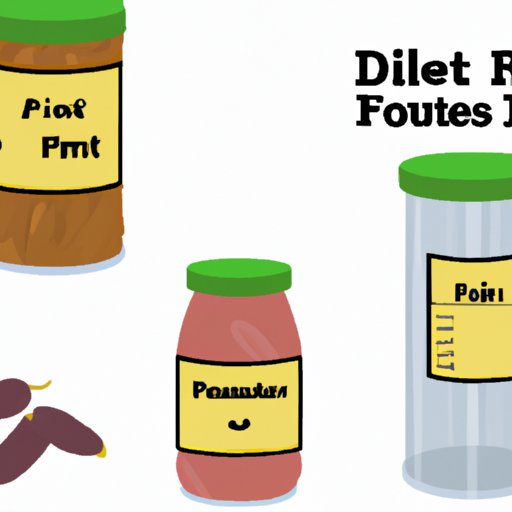
Introduction
Knowing the shelf life of common foods is vital for maintaining food safety, avoiding waste, and saving money. However, understanding how long you can keep different types of foods can be confusing, especially with the array of expiration dates and storage methods available. This article aims to provide a comprehensive guide to shelf life and food safety for common pantry staples, fresh produce, refrigerated items, leftovers, and more.
From Pantry to Fridge: A Guide to Shelf Life for Common Foods
Pantry staples such as rice, pasta, and canned goods can last for months or even years if stored properly. Airtight containers and cool, dry spaces are the key to extending shelf life. For example, flour can last up to a year when stored in a cool, dry place, while opened canned goods can last up to a week when refrigerated.
Refrigerated items such as milk, eggs, and cheese have shorter shelf lives and require specific storage methods to maintain freshness. Milk can last up to five days after the sell-by date if refrigerated at or below 40°F, while eggs can be stored in the refrigerator for up to three weeks after purchase. Cheese can last for months when wrapped tightly and stored in the refrigerator.
Preventing spoilage of food items can also prolong their life. For example, properly washing fruits and vegetables can remove bacteria and dirt that can cause spoilage. It’s also essential to make sure your refrigerator is set to the correct temperature to keep food from spoiling prematurely.
Expiration Dates Demystified: What They Really Mean and When to Toss Your Products
Expiration dates can be confusing with terms like “best by,” “sell by,” and “use by” all used to indicate different types of shelf life. “Best by” refers to the suggested date by the manufacturer for when the product should be consumed for the best quality, but it is still safe to eat after that date in most cases. “Sell by” is the date by which the product should be sold by the retailer, while “use by” is the date by which the product should be consumed.
To identify spoiled or expired products, it’s essential to trust your senses. Look for signs of mold, funky smells, or unusual discoloration or texture. If in doubt, it’s better to err on the side of caution and discard the product.
Cosmetics, spices, and medications also have shelf lives and expiration dates that should not be ignored. For example, mascara should be tossed after three to six months to avoid bacterial growth, while spices can lose their potency after six months to a year, depending on the type. Medications should always be disposed of by their expiration dates to ensure their effectiveness and safety.
The Time is Ripe: A Seasonal Guide to Storing Fresh Produce
The shelf life of fresh produce varies depending on the type of fruit or vegetable. For example, lettuce can last up to a week in the refrigerator when stored in a plastic bag, while avocados can last up to a month when stored at room temperature until they are fully ripe and then transferred to the refrigerator.
Washing and preparing produce correctly can also prolong its life. It’s best to wash fruits and vegetables right before consuming them rather than when first purchased. Removing any spoiled or wilted parts of the produce can also prevent contamination that can spoil the entire batch.
Got Leftovers? Here’s How Long You Can Keep Them
Leftovers can be a tasty and convenient way to reduce waste and save time in the kitchen. It’s essential to store leftovers within two hours after cooking and to refrigerate them promptly. Cooked meat can be stored in the refrigerator for up to four days, while cooked rice can last up to six days.
It’s also crucial to reheat leftovers properly. Food should be reheated to an internal temperature of 165°F to kill any harmful bacteria that may have grown during storage. Creative uses for leftovers include turning them into sandwiches, salads, or even adding them to soups and stews.
The Great Freezer Debate: Should You Keep These Foods Frozen or Toss Them?
Frozen foods can be a great way to save time and money while reducing waste. Commonly frozen foods such as meats, vegetables, and fruits can last for months to a year when stored correctly. It’s essential to follow proper thawing techniques by transferring frozen items to the refrigerator to thaw overnight or by slowly thawing them in cold water.
Some misconceptions about freezing foods include the idea that freezing can kill harmful bacteria, but this is not always the case. Freezing can slow the growth of bacteria, but it may not necessarily kill it. It’s also important to avoid freezing foods that have already been frozen and thawed, as this can reduce their overall quality and safety.
Preserving Your Harvest: Tips for Canning and Pickling Your Garden’s Bounty
Canning and pickling are excellent ways to store fresh produce for longer periods of time and add unique flavor profiles to meals. Proper canning techniques include sterilizing jars, using correct headspace, and using a water bath or pressure canner depending on the type of food being canned. Recipes for jams, salsas, and pickles can be found online or in canning cookbooks.
Conclusion
Understanding shelf life and food safety is essential for maintaining a healthy diet, reducing waste, and saving money. Proper storage techniques and identifying spoilage signs can prolong the life of common foods, including pantry staples, fresh produce, leftovers, and even cosmetics and medications. By following the guidelines outlined in this article, you can ensure that your food is safe to eat while also reducing waste and saving money.
Remember to trust your senses and err on the side of caution when unsure about a product’s shelf life. By preventing food waste and maintaining food safety, we can all do our part to help the environment while enjoying delicious and nutritious meals.




